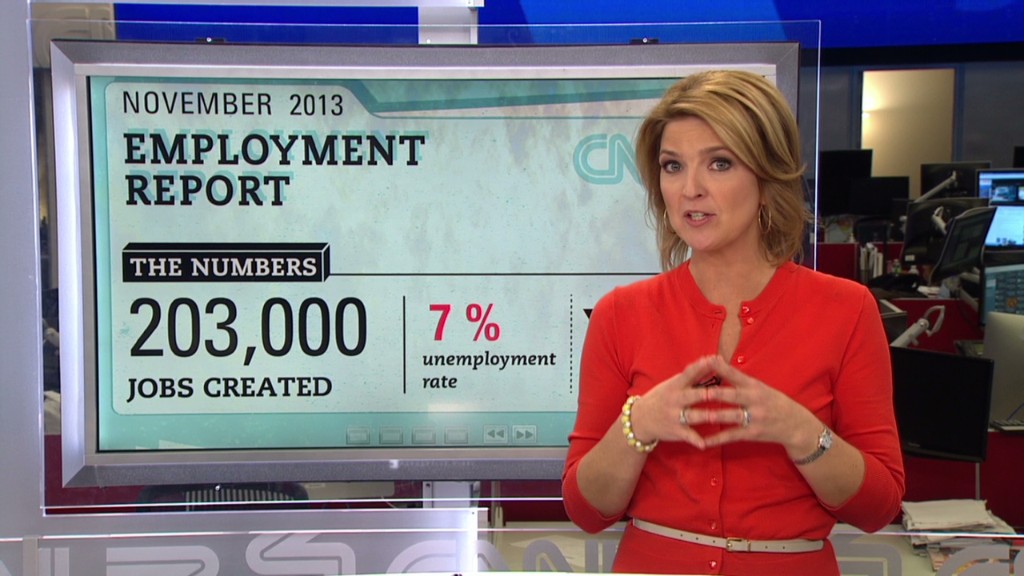
The U.S. economy is poised to add the most jobs since well before the start of the Great Recession.
The strong November jobs report was a good sign for the economy. Another month of strong hiring. A big drop in unemployment.
But the reality of the labor market is more complicated than that. There is certainly good news in the report. But there are also things to worry about. Here's the five key numbers you need to know about the current jobs market:
1) Two million jobs, again
With Friday's November jobs report, the economy is up 2.1 million jobs this year.
It's the third straight year the economy has added 2 million jobs. Even if there's a far more modest December gain, 2013 is likely to be the best year for hiring since the 2.5-million gain in 2005. The job losses of the Great Recession did not start until 2008, but the two years preceding the recession were ones of relatively modest jobs growth.
2) Falling unemployment
The unemployment rate fell to 7% for the first time in five years. Some decline was expected because the previous month's figure was distorted by October's government shutdown. But this was better than expected.
It was also an example of unemployment falling for the right reason, more people finding jobs, rather than the wrong reasons, discouraged job seekers giving up their search and no longer being counted as unemployed.
Unemployment is now down nearly a full percentage point in the past year. And the so-called underemployment rate -- which also counts those who want a full-time job but who can only find part-time work, as well as discouraged job seekers -- also improved even more, falling to 13.2% from 13.8% in October and 14.4% a year ago.
But that 13.2% underemployment rate would have been a record high before the start of the recession. And the percentage of Americans who have jobs, the flip side of unemployment that can't be distorted by people dropping out of the labor force, has stayed relatively unchanged for the last two years.
3) Still missing jobs
Even with three straight years of adding more than 2 million jobs, the economy has not recovered from the huge loss of nearly 9 million jobs in 2008 and 2009.
The economy will need to add an additional 1.3 million jobs to get back to how many people had jobs when the recession started. And the U.S. adult population has grown by more than 13 million people in those six years. So even getting back to the number of jobs before the recession won't get the economy completely out of the hole. The Economic Policy Institute calculates the overall jobs shortfall is still at nearly 8 million jobs.
4) More money in wallets
The average weekly paycheck was up slightly in November, helped by both a slight increase in hours worked, and a few pennies more on the hourly wage. Over the past 12 months, that means weekly wages have risen 2.3%
That's not a huge increase, but it is more than prices have gone up this past year -- lower gas prices have kept overall prices to only a 1% annual rise through October. Staying ahead of inflation can be a important driver of more spending by Americans, which in turn leads to more revenue for businesses and more hiring down the road.
5) Who's hiring?
The good news is that hiring has become broad based. Nearly two-thirds of businesses were adding jobs in November.
But the growth isn't how you'd think or hope it would be.
There are several sectors with good-paying jobs that have been driving the nation's economic growth this year: the housing market, auto sales, and oil and gas production, for example. But employers in those sectors have basically sat on the hiring sidelines.
Construction and real estate have added only 170,000 jobs so far this year, while auto plants have added only 40,000 jobs and the boom in oil and gas exploration has added only 7,500. So those three key sectors have together added barely more than 200,000 jobs, or a little more than 10% of hiring.
So in what sectors have the jobs been created? Nearly 1 million of the jobs have come in relatively low-wage sectors. These include retail, leisure and hospitality, temporary workers and some segments of health care such as home health care and nursing homes. That's almost half the jobs added.


